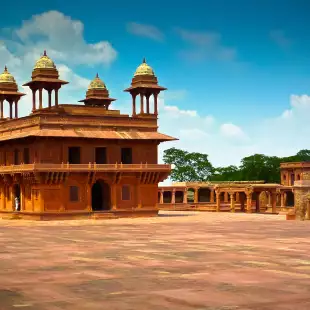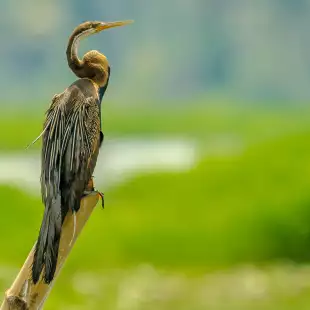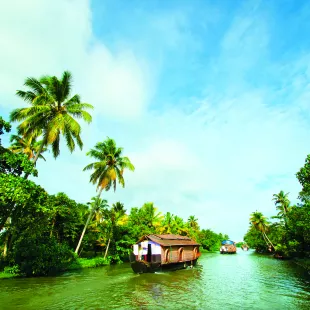Mesmerising, spiritual, and rich with colour and vibrancy, India is a holiday destination like no other.
If exploring the iconic Golden Triangle or discovering the natural wonders of the South Indian coastline are on your travel bucket list, it’s best to travel between October and March, when you can enjoy sunshine, warm temperatures and minimal rainfall.
India has a tropical climate, with the majority of the country experiencing high temperatures all year round, through the three distinct seasons. Summer (March to June) is when temperatures rise, with highs of up to 40°C in many regions, although you’ll find it slightly cooler by the coast. India’s monsoon season typically runs from June to September, sometimes stretching into October, bringing with it heavy rainfall and high humidity. Winter (November to February) is the best time to visit India, with slightly cooler temperatures ranging from 34°C to 20°C and less humidity, making sightseeing and outdoor excursions far more comfortable and enjoyable.
Don’t think about, just book it! You won’t regret it 5* service. If you want to travel well without the stress - look no further.

What to expect from India in January
January sits in the middle of India’s winter season and it’s generally the driest month of the year. Despite being winter, January still enjoys warm weather and balmy evenings, with comfortable humidity and daily temperatures ranging between 33°C to 20°C. If you’re planning a coastal holiday, January is one of the best times of the year to visit Goa. The average temperature is 28°C and there’s no chance of rain, perfect for exploring the area.
While you may not associate India with snow, Shimla in the very north of the country is a popular winter sports destination in January through to March. Its position in the Himalayan foothills makes it India’s most popular ski resort.

Festivals and Events in January
- Pongal
- Usually falls on 14th to 17th January
- Annual three- or four-day Hindu harvest festival celebrated by Tamils
- Marks the end of winter solstice
- Cattle play an important part in the festival. Here they are bathed, their horns are polished and painted in bright colours and flower garlands are placed around their necks before a procession
- Traditional dish of Pongal is prepared using milk, rice and jaggery (unrefined sugar made from cane or palm)

What to expect from India in February
February is the last winter month in India, and you can expect similar weather conditions to January with warm temperatures (33°C to 22°C) and a low chance of rainfall.
February is generally the best time to visit coastal regions like Kerala, where pleasant and dry weather make it ideal for a quiet, relaxing holiday now the Christmas and New Year crowds have gone. With winter coming to an end, this is also a good month to visit Delhi, when flowers are blooming, with tulips, cherry blossom and bougainvillea filling the city with colour.

What to expect from India in March
March marks the start of the Indian summer, with temperatures climbing slightly and humidity rising. The average daily maximum temperature sits at around 34°C and the average daily minimum at 24°C. March is one of the best times to visit the Golden Triangle, as you can enjoy comfortable temperatures, dipping slightly at night, without the crowds of winter holidaymakers.

Festivals and events in March
- Holi
- Popular two-day Hindu festival also known as the Festival of Colours, Love and Spring
- On the first night of Holi, bonfires are lit symbolising the triumph of good over bad
- The next day people of all ages take to the streets to playfully throw coloured water and bright powder paints at each other and into the air. Visitors are joyfully encouraged to join in too, so embrace the experience
- It marks the arrival of spring and the end of winter, celebrating the Hindu god Krishna and the legend of Holika and Prahlad
- Eid (March or April)
- Indian Muslims celebrate this festival, marking the end of the month-long, dawn-to-sunset fasting of Ramadan
- Eid is marked with prayers, then family and friends come together to enjoy an opulent feast and exchange gifts

What to expect from India in April
The weather really starts hotting up in April, with highs of around 38°C. To avoid the high daytime temperatures, plan your excursions or sightseeing for early morning or evening.
Despite the increasing temperatures, April is one of the best months for wildlife spotting in India’s national parks – especially around the in-demand watering holes. April is also the best time to visit Shimla to make the most of the blossoming flowers and lush greenery. The cooler temperatures in the north also provide a refreshing break from the heat of the south.

What to expect from India in May
May is typically the hottest month of the year in India, with soaring temperatures reaching up to 45°C. Along with the heat it can be uncomfortably humid across much of India in May, with the exception of the far north. Temperatures are lower in the Indian Himalayas and humidity levels are much more bearable, making light mountain hiking a feasible option. May offers fantastic value trips to India, if you can manage the heat.

What to expect from India in June
June sees the start of monsoon season across most of southern and central India, bringing heavy and persistent rainfall. The northern regions of India typically experience very high humidity and frequent thunderstorms throughout early June, as the monsoon works its way up the country. By the end of the month the majority of the country will be affected by the rainy season, with temperatures remaining high.

What to expect from India in July
With monsoon season well underway, July is predictably the wettest month of the year in India. Temperatures might have dipped a few degrees, but humidity remains uncomfortably high.
While most of the country is affected by the heavy rain, July does offer some travel opportunities. This is the perfect month to visit Ladakh, a high-altitude desert at the northern tip of India. With an average daytime temperature of 25°C and little rainfall, it’s a unique corner of the country with a dramatic landscape of craggy cliffs and vast lakes. It also offers plenty of activities for adventure-seeker travellers, from trekking to white water rafting.

What to expect from India in August
With an average daytime high of 31°C and an average low of 25°C, August is typically the coldest month of the year in India. While still very much in monsoon season, the level of rainfall is far less than July and in the far north of the country you can expect sunshine between the showers.

Festivals and events in August
- Onam (August to September)
- Annual 10-day Hindu festival
- Considered the official festival of the state of Kerala
- Men and women wear traditional dress for the celebrations
- There is a parade featuring decorated elephants, drummers, music, floats and people in colourful dress
- Celebrations also include boat races, sports competitions, dancing, martial arts and floral artwork (Rangoli)
- Ganesh Chaturthi (August or September)
- Celebrated on the fourth day of the month of Bhadrapada (August-September)
- 10-day Hindu festival marking the birth of the elephant-headed deity Ganesh, the god of prosperity and wisdom
- It’s one of the biggest Hindu celebrations in India, with large public events across the country
- Statues of Ganesh are covered in a special paste, as well as yellow and red flowers. Offerings are made to Ganesh, including coconut and modak dumplings which people believe are his favourite food. Ganesh is worshipped for 10 days
- The statues are transported in large procession to rivers, lakes or the sea and immersed in the water to symbolise his journey back home to his parents
- Krishna Janmashtami (August or September)
- Festival celebrating the birthday of the Hindu god Krishna
- Celebrations start at midnight, when Krishna is thought to have been born
- Statues of Krishna are bathed in milk and water, dressed in new clothes and displayed in homes or temples
- Meals are prepared using milk and curds (ingredients believed to have been favoured by Krishna)
- Expect music, singing, dancing and plays re-enacting scenes from the god’s life
- One tradition includes creating a human pyramid, with a young boy at the top. He must reach a clay pit filled with buttermilk, then smash it, so the buttermilk spills

What to expect from India in September
The rainy season is coming to an end and now is an excellent time to book a great value holiday to Rajasthan, especially towards the end of the month. Although there is still the chance of rain, it is greatly reduced compared to the past two months, humidity levels are low and the temperatures are more bearable, hovering around 30°C.
Across the rest of the country weather in September can be a mixed bag, with Kerala and Darjeeling in particular still experiencing rainfall.

What to expect from India in October
October sees the tail-end of the monsoon season and the welcome return of warm, sunny days. The average daily temperature range from 33°C to 24°C, so now is one of the best times to visit the Taj Mahal before the peak travel season begins.
If you can be patient, October is the month to witness the unique natural phenomenon of the Neelakurinji flowering season in Kerala. The hills of Munnat are covered in a vibrant carpet of colour when these purplish-blue flowers bloom, however this only happens every 12 years, with the next flowering season due in 2030.

Festivals and events in October
- Gandhi Jayanti
- 2nd October. Indian national holiday to mark the birthday of Mahatma Gandhi
- Pushkar Fair (October to November)
- Held late October to November in Pushkar, Rajasthan
- One of India’s largest camel, horse and cattle fairs, with around 50,000 animals, along with their owners, arriving in Pushkar
- The fair features many cultural events including dancing, tug of war, camel racing and the “longest moustache” competition
- Diwali (October to November)
- Hindu festival of lights
- India’s biggest and most important holiday of the year, lasting five days
- Joyful celebration where people pray, enjoy meals together and give out sweets
- Colourful firework displays light up the skies
- People light up their homes with small oil lamps called diyas and paper lanterns to celebrate the victory of light over darkness

What to expect from India in November
November really is one of the best months to travel in India, with dry and sunny weather across the country and low humidity. The conditions are ideal for sightseeing, outdoor excursions or simply a quiet break relaxing on the beach. In November, Goa and Kerala enjoy temperatures of around 32°C, while Rajasthan sits around 28°C, with minimal to no rainfall.
Naturally, with conditions this perfect for exploring the country, November sees the start of the busy tourist season, but don’t let that put you off. November is one of the best times to visit the national parks in India, with the rainy season leaving the parks vibrant and full of vegetation. Despite the warm daytime temperatures, the November mornings can be chilly if you’re heading on safari tiger watching, so bring gloves and plenty of layers.

What to expect from India in December
Tempted by the warm sunny days, December is naturally a popular month for travellers to India. Conditions during December are ideal for exploring the Golden Triangle and December is one of the best times of year to visit the Taj Mahal, with the average daytime temperature hovering around 24°C. But do get there as early as possible or visit late afternoon to avoid the main crowds.
If you’re searching for a winter sun beach holiday, Goa ticks all the boxes in December, with temperatures in the low to mid 30°Cs and clear blue skies. Just make sure you plan well in advance as flights and accommodation can get booked up very quickly during these popular months, especially over Christmas and New Year’s.

Festivals and events in December
- Christmas
- Though the majority of Indians are Hindu, millions of people still celebrate Christmas in India
- Most hotels in India will serve a special Christmas dinner of some kind, whether that’s an Indian feast or a traditional Christmas buffet of turkey and all the trimmings
- Goa has a large Catholic population, and here you can expect decorated houses, Christmas carols and even Midnight Mass on Christmas Eve
Fascinating insight into the history and the contrasts of everyday life as we travelled from east to west. Well organised trip, great tour leader, enthusiastic local guide, comfortable bus kept in immaculate condition...
Frequently asked questions
While you’re never going to have the Taj Mahal all to yourself, there are certain times of the day when it will be less crowded. Visiting the Taj Mahal during winter months means you’ll be able to enjoy this dazzling monument without the weather getting in the way, but this is peak visitor season. The quietest time to visit the Taj Mahal is early in the morning. Aim to arrive for when the Taj opens at 6am and marvel at the beauty of this iconic building as the sun rises. Alternatively, arriving late afternoon, as the crowds start to thin out, is also another quiet time to visit the Taj Mahal.
Average temperatures by month
| Jan | Feb | Mar | Apr | May | Jun | Jul | Aug | Sep | Oct | Nov | Dec | |
| Chennai | 25°C | 26°C | 28°C | 30°C | 32°C | 31°C | 30°C | 30°C | 29°C | 28°C | 26°C | 25°C |
| Delhi | 13°C | 17°C | 23°C | 29°C | 33°C | 33°C | 31°C | 30°C | 29°C | 25°C | 20°C | 15°C |
| Goa | 27°C | 27°C | 28°C | 29°C | 29°C | 28°C | 27°C | 27°C | 27°C | 28°C | 28°C | 27°C |
| Mumbai | 24°C | 25°C | 28°C | 29°C | 30°C | 29°C | 28°C | 28°C | 28°C | 29°C | 28°C | 26°C |
Average rainfall by month
| Jan | Feb | Mar | Apr | May | Jun | Jul | Aug | Sep | Oct | Nov | Dec | |
| Chennai | 19mm | 10mm | 9mm | 19mm | 40mm | 48mm | 70mm | 93mm | 99mm | 227mm | 282mm | 110mm |
| Delhi | 14mm | 20mm | 13mm | 16mm | 25mm | 76mm | 163mm | 171mm | 97mm | 15mm | 4mm | 7mm |
| Goa | 1mm | 2mm | 4mm | 13mm | 91mm | 497mm | 564mm | 375mm | 191mm | 95mm | 22mm | 4mm |
| Mumbai | 1mm | 2mm | 1mm | 2mm | 51mm | 413mm | 593mm | 419mm | 265mm | 79mm | 10mm | 3mm |










































